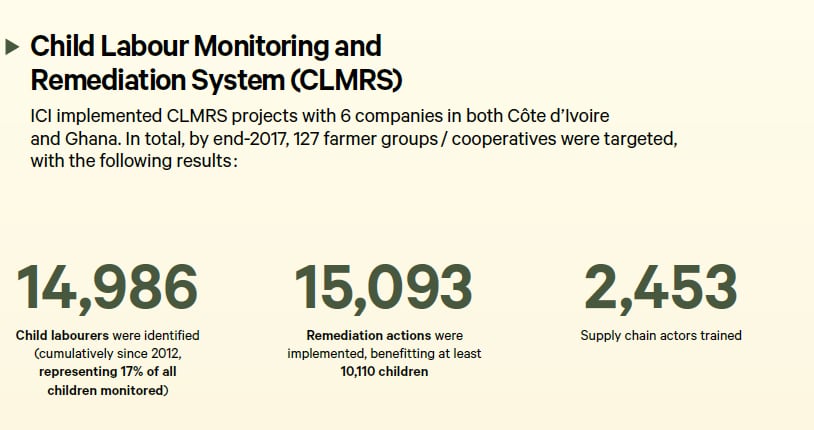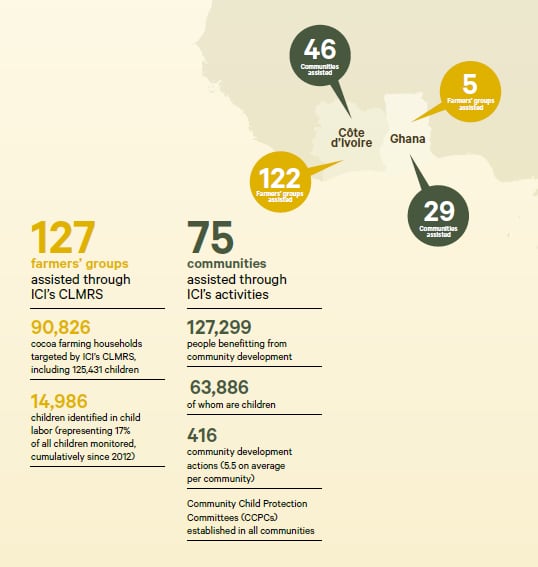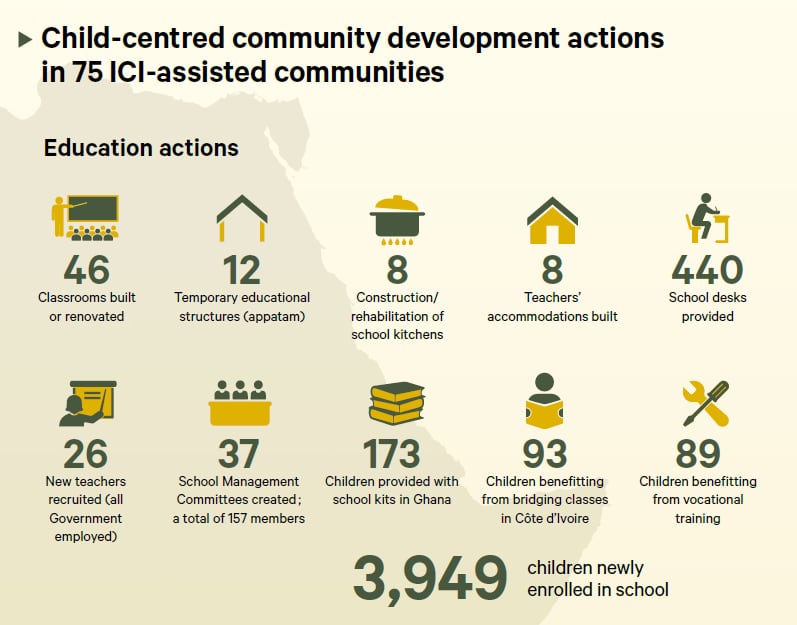In its 2017 annual report, released on 12 June, the World Day against Child Labor, the ICI noted the number accounts for roughly 17% of the 91,000 farming households – 125,000 children in total – it monitored using its child labor monitoring and remediation system (CLMRS).

Nick Weatherill, executive director at the ICI, said some of the cocoa farmers are simply too poor not to put their children at work, and they are afraid of being reported.
“That fear of being punished is what drives the problem underground because the whole [CLMRS] depends on farmers being honest, in a way of self-declaring,” he said.
Identifying child labor and feasible solutions
Weatherill explained the ICI’s process of identifying child labor starts with educating farmers about the danger of using child labor.
Community agents with smartphones are sent to farming households to conduct on-site interviews, particularly with children. When a family is flagged as suspected child labor case, it will receive a follow-up visit.
“It’s not always possible to solve the whole thing: sometimes you have kids whose father just died, and the mother has look after five to six kids,” said Weatherill.

However, he noted families found using child labor will not be immediately punished.
“As long as they don’t have alternatives, i.e. they are either too poor to get their kids into a school or there is no school in the community which is very common, we’d help the children and their families in the first place,” said Weatherill.
He noted some of the ways to help include one-on-one education sessions with the parents.
“But if they live in absolute poverty, we will enroll the mother in an income-generating activity such as farming or food processing. Trying to get money into mothers’ pockets is a good strategy because data shows mothers are 10 times more likely to spend their interest and money on their children than men,” said Weatherill.
“We’ll also set up a group of young men, who are available in the community, to do some of the hazardous, heavy tasks that might be otherwise given to children,” he added. “We help build schools and make sure there are enough good quality teachers.”
The ICI said 3,949 children were newly enrolled in school between 2016 and 2017 as a direct result of its actions in 75 cocoa farming communities.
However, there are extreme cases in which a child is repeatedly abused or overtly exploited.
“We don’t find many of these cases, but when they do happen, that’s when we fast track the case and report it to the local police or law enforcement,” added Weatherill.
Working with chocolate and cocoa companies
According to Weatherill, seven companies, including Mondelēz, Nestlé, Cargill, Barry Callebaut, Olam Cocoa and Tony’s Chocoloney and ECOM are currently using CLMRS to prevent child labor.
However, even though Hershey is one of the founding members of the ICI, it has yet to directly use the monitoring system.
“Hershey just overhauled its cocoa sustainability program. We’re currently in discussion and there are good prospects that we’ll be a partner in helping them roll out their new strategy [later this year],” said Weatherill.
Hershey’s spokesperson, Jeff Beckman, told ConfectioneryNews some of the company’s suppliers have started using CLMRS.
“Hershey is also working with CARE to implement a portion of ICI’s CLMRS needs. All models will be tested to understand the impact and effectiveness.
“All of this work is done through our Hershey’s ‘Learn to Grow’ program and implemented in several Hershey-sponsored cocoa communities. This work will help Hershey and our partners identify and understand incidences and causes of child labor so that appropriate remediation activities can be undertaken,” added Beckman.
Weatherill said CLMRS this year is expected to reach 120,000 farming households across 127 cooperative groups in Côte d’Ivoire and Ghana. The ICI is also expanding its coverage to other cocoa-producing regions in West Africa.
‘Certification has been a blunt instrument in tackling child labor’
Despite that, these large chocolate companies have had many of their products certified using Fairtrade or Rainforest Alliance labels, Weatherill argued, “certification has been a blunt instrument in tackling child labor.”

He said, “certifications can help farmers grow more cocoa and earn more money, but these cocoa sustainability commitments that have previously been benchmarked to tonnage of certified cocoa may not be sharp enough on the issue of child labor.
“Being certified doesn’t mean farmers don’t live above the poverty line and it doesn’t guarantee there isn’t child labor.”
However, sustainable cocoa would ensure farmers’ wellbeing, he added.
“Each company defines its sustainability commitment slightly different from another, although the benchmark has always been the percentage of certified cocoa beans.
“That said, many companies are doing more than committing to certified tonnages. For instance, Hershey puts a big emphasis on child nutrition, which is an indirect root cause of child labor,” he explained.
Certifiers, such as Rainforest Alliance and UTZ (two organizations merged last year), are currently working with the ICI to adapt their certification codes, “so down the road, certified cocoa can also have a significant impact on reducing child labor,” added Weatherill.
